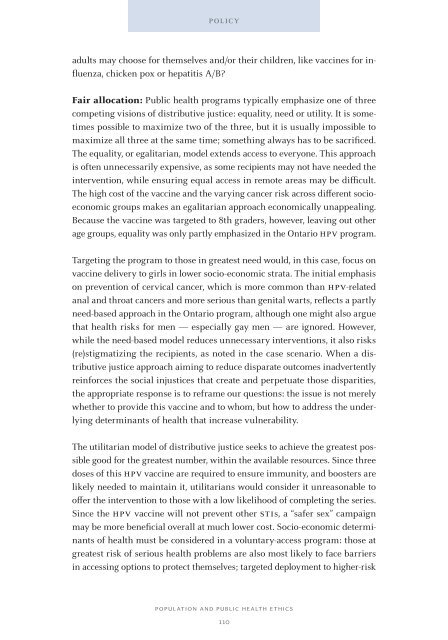PoPulationand Public HealtH etHics
PoPulationand Public HealtH etHics
PoPulationand Public HealtH etHics
Create successful ePaper yourself
Turn your PDF publications into a flip-book with our unique Google optimized e-Paper software.
policy<br />
adults may choose for themselves and/or their children, like vaccines for influenza,<br />
chicken pox or hepatitis A/B?<br />
Fair allocation: <strong>Public</strong> health programs typically emphasize one of three<br />
competing visions of distributive justice: equality, need or utility. It is sometimes<br />
possible to maximize two of the three, but it is usually impossible to<br />
maximize all three at the same time; something always has to be sacrificed.<br />
The equality, or egalitarian, model extends access to everyone. This approach<br />
is often unnecessarily expensive, as some recipients may not have needed the<br />
intervention, while ensuring equal access in remote areas may be difficult.<br />
The high cost of the vaccine and the varying cancer risk across different socioeconomic<br />
groups makes an egalitarian approach economically unappealing.<br />
Because the vaccine was targeted to 8th graders, however, leaving out other<br />
age groups, equality was only partly emphasized in the Ontario HPV program.<br />
Targeting the program to those in greatest need would, in this case, focus on<br />
vaccine delivery to girls in lower socio-economic strata. The initial emphasis<br />
on prevention of cervical cancer, which is more common than HPV-related<br />
anal and throat cancers and more serious than genital warts, reflects a partly<br />
need-based approach in the Ontario program, although one might also argue<br />
that health risks for men — especially gay men — are ignored. However,<br />
while the need-based model reduces unnecessary interventions, it also risks<br />
(re)stigmatizing the recipients, as noted in the case scenario. When a distributive<br />
justice approach aiming to reduce disparate outcomes inadvertently<br />
reinforces the social injustices that create and perpetuate those disparities,<br />
the appropriate response is to reframe our questions: the issue is not merely<br />
whether to provide this vaccine and to whom, but how to address the underlying<br />
determinants of health that increase vulnerability.<br />
The utilitarian model of distributive justice seeks to achieve the greatest possible<br />
good for the greatest number, within the available resources. Since three<br />
doses of this HPV vaccine are required to ensure immunity, and boosters are<br />
likely needed to maintain it, utilitarians would consider it unreasonable to<br />
offer the intervention to those with a low likelihood of completing the series.<br />
Since the HPV vaccine will not prevent other stIs, a “safer sex” campaign<br />
may be more beneficial overall at much lower cost. Socio-economic determinants<br />
of health must be considered in a voluntary-access program: those at<br />
greatest risk of serious health problems are also most likely to face barriers<br />
in accessing options to protect themselves; targeted deployment to higher-risk<br />
PoPulation anD <strong>Public</strong> <strong>HealtH</strong> <strong>etHics</strong><br />
110
















